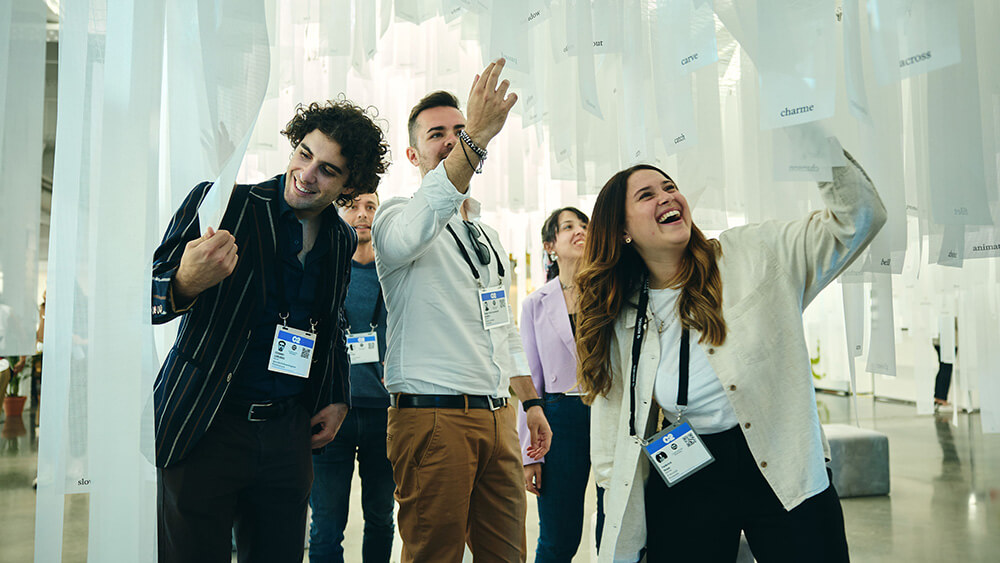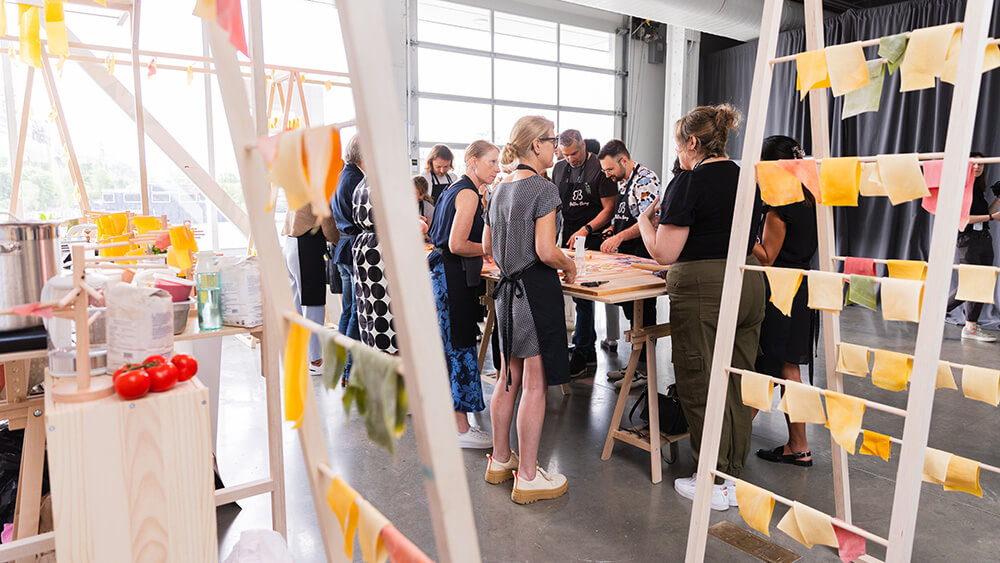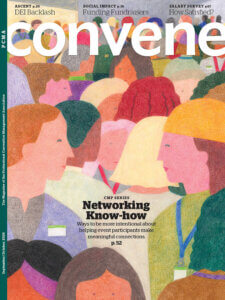
About C2 Montreal’s various formats, CEO Anick Beaulieu said, “It’s just about the diversity of ways to connect and touch points that create this rich, fertile ground for friendship, partnership, transactions to happen.”
Anick Beaulieu was recently a presenter at a conference in Abu Dhabi for architects, when she experienced “total imposter syndrome,” the CEO of Montréal-based event company C2 told Convene during a video interview. In the audience were “some of the best architects in the world,” she said. “I was like, ‘Oh, my God. What am I doing here?’”
Beaulieu said she realized that other presenters were showing images of “pristine environments — no humans — very beautiful lines, great Scandinavian feel.” And it came to her: “What we’re doing” — speaking as the head of one of the most forward-thinking business events in the world — “is architecting human connections.”
As she reflected on that, Beaulieu said, she thought about how everything C2 does as an event company is around finding ways to multiply those connections that are “inclusive of different job titles, hierarchy in a company, men and women, different cultures, different neurodiverse backgrounds, [whether you’re] an introvert [or] an extrovert, with moments of high energy and low energy.” It struck her, she said, that it’s C2’s job to make “deeper and more meaningful” connections among its participants. “When you look at it through this lens,” she added, “we believe that businesses don’t do business together, humans do.”
Here’s more of Beaulieu’s take on the complex nature of making human connections, and why it is such a wellspring of creativity for C2 organizers.
How has networking evolved at C2 and in general?
I think traditionally, the way to treat networking in a corporate setting has been very transactional. The premise is like, “I’m going to have a booth, hand out business cards, or I’m going to go to a cocktail hour, sponsored by some brand that has a name on the bar and/or napkins.”

Anick Beaulieu, CEO of Montréal-based event company C2, says C2’s secret sauce for its creative business conference is designing beautiful environments and methodologies to forge connections between participants.
Our vision is, we believe that humans connect and we believe that humans do good together. We believe that commerce or economic impact is also driven by people meeting and doing business together. When we look at the power of creativity — and I think that this is where a lot of what we do finds its source — beautiful environments have the power to inspire and to create things to talk about, to connect.
Same thing with methodologies. When we think about workshops or masterclasses, it’s once again providing a context, so a speaker, a topic, but then designing a methodology that gets people in groups working together. When you tackle a problem with someone, there’s actually more of a chance that you’ll find common points of view or knowledge that one can bring to another, and that you’ll want to pursue the conversation after the activity.
We see that we’ve provided the context for that connection. Same thing when you look at some of the signature experiences we’re known for, like the Sky Lab, where we suspend people [in chairs] up in the air. Once again, if you’re up in the air with someone you don’t know at a business event, there’s a lot more chance that you’re going to keep the conversation going or that you’ll meet that person a day later at a cocktail [reception] — because we still believe in wine and food [laughs] — to have this conversation.
How do you keep creating new and novel ways to connect year after year?
When you ask us how we are going to still evolve, it’s really centered on how do we multiply the number of connections that are happening at any given time during an event. When you look at KPIs for events, usually it’s like, how many leads do we have? How much money did we generate? How much interaction did we get on social? How well did our content perform? It’s all about that connection. It’s either connecting people together to do business or it’s about connecting to an audience, like a digital audience that will be interested in your product or whatever.
For us, it’s really about finding the different formats, the way to leverage creativity that will get us closer to generating more of these interactions, which usually will end up being us reaching more KPIs, or growing the brand, or getting more ticket sales because we’ve connected in a way that was unique with our audience.

During a lasagna lab at this year’s C2 Montréal conference, participants explored the importance of being inclusive to different types of neurodiversity while cooking lasagna.
Can you give us an example of a new format you tried this year at C2 in May?
We had a neurodiverse lasagna lab. That was exploring the importance of being inclusive to different types of neurodiversity, as people were talking about their own neurodiverse profiles or situations that related to them while cooking lasagna. Why cooking lasagna? Because when you’re cooking, when you’re in contact with food, when you’re sharing this beautiful moment with people, your guards are down, your barriers are down, and you are actually focusing on what you’re doing rather than focusing on, “What should I be saying? What would look good in this context? I don’t want that person to judge me.” By stripping this, you are actually allowing yourself to be more authentic and then can create a real connection with someone next to you.
One of the things we explored this year was when we approach a certain topic, to have multiple points of view contribute to the conversation on stage. What that does is that it fuels your desire to keep talking about what you just heard because there’s a little friction, there’s a little conflict, there’s an opinion in there. It’s not vanilla. You’re like, “Oh, that person said that. I don’t know if I agree, but that person said that, and I’m totally aligned. Are you?”
Then we had a quiz, which was an AI tool telling you if you were relevant or obsolete. We had people in the audience getting on stage, participating as if it was a televised quiz.
We brought back Braindate this year. And we had a bunch of really interesting food experiences and restaurants, then some more traditional — we’re not against a traditional good cocktail [party] with a great curated list of people mingling after a day that was filled with so many experiences and content.
I think for us, it’s just about the diversity of ways to connect and touch points that create this rich, fertile ground for friendship, partnership, transactions to happen.
You spoke about high energy and low energy. How do you build those two extremes into the program?
The lasagna lab — that’s high energy because you’re making stuff while discussing, you’re in a group, there’s this notion of you really need to be out there in the world in a way. Even if we hack a way to make people feel comfortable, you’re still contributing, you’re still in a social setting.
On the flip side, we had an introspective lab, which was around language models and what has been our relationship to language — or even animals’ relationship to language — and how will it evolve or change once we start having language models that are machine generated. That was very much about being in your own little bubble in a beautiful environment with a headset. Very introspective, very much about your thoughts — so less about having to perform or feel engaged in a conversation. We also have multiple lounges. Some of them are in high-traffic areas where you could just walk around, see someone, stop and say hi, but some that were a bit more remote that allowed people to just take a bit of time to go through emails, and, I don’t know, maybe take a little nap.
We also did this within the restaurants we designed. Some of the restaurants were really open-floor [plans], giving you the opportunity to connect with people while you’re eating, but we created small coves that allowed more intimate, private conversations. Same thing with our partner lounges, part of them facing out, part of them being more private. Then even in the programming — we opened up with a Witch Opera that was all about vibrations and this moment where you were in tune with something that was a bit spiritual, but then kicking it off with very dynamic content.
You spoke about people making connections that last throughout the year. Any examples?
Actually, two entrepreneurs who met in one of the Ferris wheels during C2 ended up founding a business together, they got married, and they had a kid. That’s the most extreme example!
Michelle Russell is editor in chief of Convene.
On the Web
In addition to producing its flagship business conference C2 in Montréal annually, the company produces “experiences in white label for some of the world’s top brands,” C2’s Anick Beaulieu said, and has a partnership with Accor Group to develop spaces “that are meant to host meetings in a way where they are more collaborative, flexible, and cooler.” Learn more at c2international.com.

Read the Sept.-Oct. Convene issue as it appeared in print in our digital edition.
Earn CMP Credit
In the following stories from Convene’s September-October CMP Series, we share how event organizers are creating innovative and flexible spaces and formats that foster meaningful connections. You can earn one clock hour of CMP certification by visiting the CMP Series web page to answer questions about the networking articles below.
- Architects of Connection: Event Organizers Offer New Ways to Network
- Higher Ed, Advanced Networking
- Beyond the Old Boys’ Club: How Women Are Networking Their Way
- Why Are These Women-Only Networking Spaces So Popular?
- Leaning Into Connections Is the Secret to This Event’s Success
- Designing ‘A Beautiful Nesting Ground’ for Deeper Relationships
- Event Attendees ‘Don’t Want to Waste Their Time Anymore’
The Certified Meeting Professional (CMP) is a registered trademark of the Events Industry Council.
